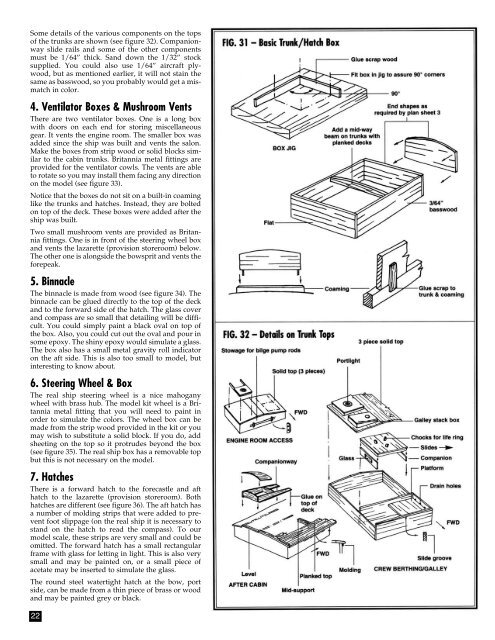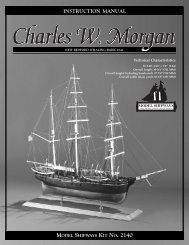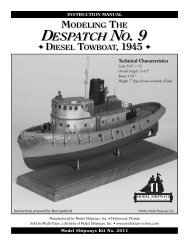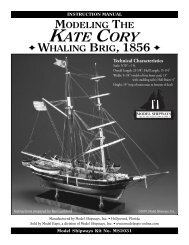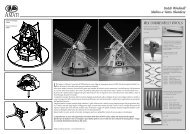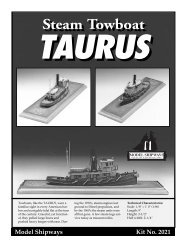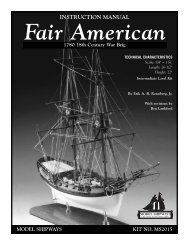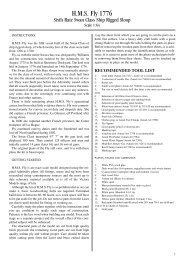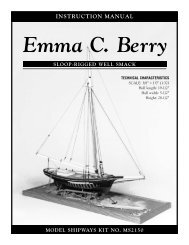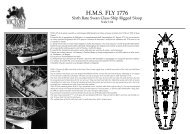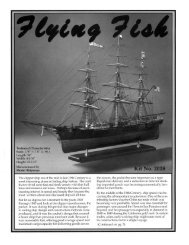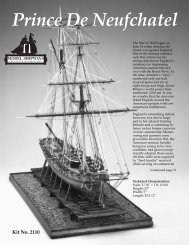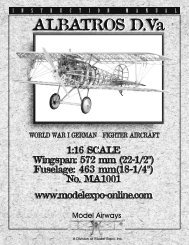download baltimore instruction manual
download baltimore instruction manual
download baltimore instruction manual
You also want an ePaper? Increase the reach of your titles
YUMPU automatically turns print PDFs into web optimized ePapers that Google loves.
Some details of the various components on the tops<br />
of the trunks are shown (see figure 32). Companionway<br />
slide rails and some of the other components<br />
must be 1/64” thick. Sand down the 1/32” stock<br />
supplied. You could also use 1/64” aircraft plywood,<br />
but as mentioned earlier, it will not stain the<br />
same as basswood, so you probably would get a mismatch<br />
in color.<br />
4. Ventilator Boxes & Mushroom Vents<br />
There are two ventilator boxes. One is a long box<br />
with doors on each end for storing miscellaneous<br />
gear. It vents the engine room. The smaller box was<br />
added since the ship was built and vents the salon.<br />
Make the boxes from strip wood or solid blocks similar<br />
to the cabin trunks. Britannia metal fittings are<br />
provided for the ventilator cowls. The vents are able<br />
to rotate so you may install them facing any direction<br />
on the model (see figure 33).<br />
Notice that the boxes do not sit on a built-in coaming<br />
like the trunks and hatches. Instead, they are bolted<br />
on top of the deck. These boxes were added after the<br />
ship was built.<br />
Two small mushroom vents are provided as Britannia<br />
fittings. One is in front of the steering wheel box<br />
and vents the lazarette (provision storeroom) below.<br />
The other one is alongside the bowsprit and vents the<br />
forepeak.<br />
5. Binnacle<br />
The binnacle is made from wood (see figure 34). The<br />
binnacle can be glued directly to the top of the deck<br />
and to the forward side of the hatch. The glass cover<br />
and compass are so small that detailing will be difficult.<br />
You could simply paint a black oval on top of<br />
the box. Also, you could cut out the oval and pour in<br />
some epoxy. The shiny epoxy would simulate a glass.<br />
The box also has a small metal gravity roll indicator<br />
on the aft side. This is also too small to model, but<br />
interesting to know about.<br />
6. Steering Wheel & Box<br />
The real ship steering wheel is a nice mahogany<br />
wheel with brass hub. The model kit wheel is a Britannia<br />
metal fitting that you will need to paint in<br />
order to simulate the colors. The wheel box can be<br />
made from the strip wood provided in the kit or you<br />
may wish to substitute a solid block. If you do, add<br />
sheeting on the top so it protrudes beyond the box<br />
(see figure 35). The real ship box has a removable top<br />
but this is not necessary on the model.<br />
7. Hatches<br />
There is a forward hatch to the forecastle and aft<br />
hatch to the lazarette (provision storeroom). Both<br />
hatches are different (see figure 36). The aft hatch has<br />
a number of molding strips that were added to prevent<br />
foot slippage (on the real ship it is necessary to<br />
stand on the hatch to read the compass). To our<br />
model scale, these strips are very small and could be<br />
omitted. The forward hatch has a small rectangular<br />
frame with glass for letting in light. This is also very<br />
small and may be painted on, or a small piece of<br />
acetate may be inserted to simulate the glass.<br />
The round steel watertight hatch at the bow, port<br />
side, can be made from a thin piece of brass or wood<br />
and may be painted grey or black.<br />
22


